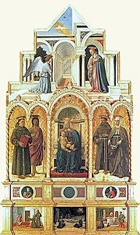Piero Benedetto de' Franceschi (Piero della Francesca) trained in his native Borgo Santo Sepolcro before spending a short period in Florence in ca. 1440. His most famous surviving works are the frescoes (1452-6) of scenes from the Legend of the True Cross in the Duomo, Arezzo. He had a deep interest in perspective, and published at least three mathematical treatise on the subject.
Perugia
St Antony of Padua Polyptych (ca. 1468)

The nuns removed the altarpiece from this altar in 1608, and it was documented soon after in the sacristy. It was moved to the altar of the inner church in 1668 (where it replaced an altarpiece by Raphael that the impoverished nuns had been forced to sell). It was confiscated in 1798, returned soon after, but transferred definitively to the Accademia di Belle Arti in 1810. Two of the predella panels were subsequently dispersed but later returned to Perugia. The altarpiece was recomposed in the Galleria Nazionale in 1921.
The figures in the main register occupy a unified space behind the framing, and are set against a backdrop of golden brocade. They depict:
-
✴the Madonna and Child enthroned (in the central panel);
-
✴SS Antony of Padua and John the Baptist (to the left); and
-
✴SS Francis and Elizabeth of Hungary (to the right).
The magnificent panel in the upper storey depicts the figures of the Annunciation in front of an arcade that appears to be a mathematical study in perspective. It is possible that this part of the altarpiece was originally intended to be rectangular, but that it was cut into a cusped shape to harmonise with the Gothic apse in which the altarpiece was placed.
The altarpiece has a double predella:
-
✴The upper predella panel contains half length images in tondi of SS Clare (to the left) and Agatha (to the right). It seems that the empty central panel of the predella was hinged so that the priest could serve the Eucharist to the sisters in the inner church.
-
✴The lower predella panels depict scenes involving the Franciscan saints in the main register:
-
•St Antony raising a child from the dead;
-
•the stigmatisation of St Francis; and
-
•St Elizabeth saving a boy from drowning in a well.
Read more:
M. Aronberg Lavin, “Piero Della Francesca”, (2002), London
V. Garibaldi (Ed.), “Piero Della Francesca: Il Polittico di Sant' Antonio”, (1993), Perugia
Return to Art in: Perugia.
Return to “Foreign” Painters in Umbria.



